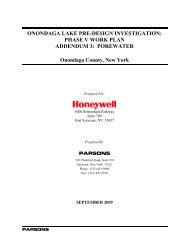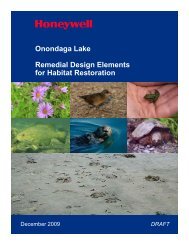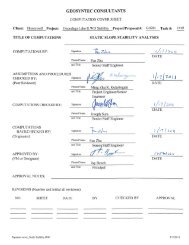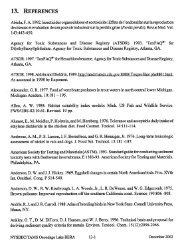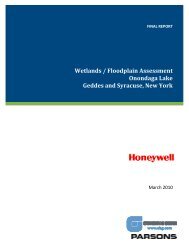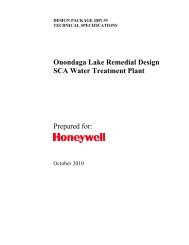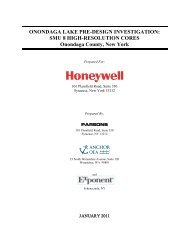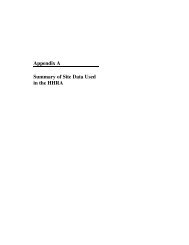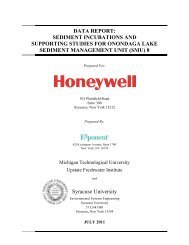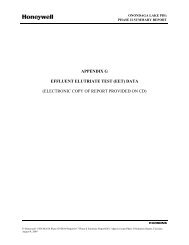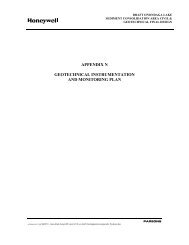Phase 1B Underwater Archaeological Report for the Onondaga ...
Phase 1B Underwater Archaeological Report for the Onondaga ...
Phase 1B Underwater Archaeological Report for the Onondaga ...
You also want an ePaper? Increase the reach of your titles
YUMPU automatically turns print PDFs into web optimized ePapers that Google loves.
FINAL<br />
<strong>Phase</strong> IB <strong>Underwater</strong> <strong>Archaeological</strong> Resources <strong>Report</strong> <strong>for</strong> <strong>Onondaga</strong> Lake Superfund Site<br />
1898), and that prior to <strong>the</strong> nineteenth century <strong>the</strong> lake level may have been approximately 365 to 369<br />
feet (113 to 112.5m) ASL. 21<br />
Construction of <strong>the</strong> Oswego Canal in <strong>the</strong> 1810s and 1820s along <strong>the</strong> eastern shore of <strong>the</strong> lake required<br />
<strong>the</strong> marshy shoreline to be rein<strong>for</strong>ced with timber. Various mid-nineteenth and early twentieth century<br />
maps indicate that <strong>the</strong> reclaimed shoreline along <strong>the</strong> sou<strong>the</strong>rn and sou<strong>the</strong>astern part of <strong>the</strong> lake was<br />
anywhere from 200 to 3000 feet (61 to 914m) inland from <strong>the</strong> contemporary shoreline. 22 A 1908<br />
Hopkins map identified areas of “reclaimed land,” and <strong>the</strong> original shoreline of <strong>the</strong> sou<strong>the</strong>rn part of <strong>the</strong><br />
lake as approximately 300 to 1000 feet (91 to 305m) inland of <strong>the</strong> contemporary shoreline. The 1908<br />
Hopkins map is also <strong>the</strong> first to indicate that <strong>the</strong> Solvay Process Company began placing waste into and<br />
along <strong>the</strong> shoreline of <strong>Onondaga</strong> Lake. Along Lake View Point, <strong>the</strong> Solvay Company had piled waste over<br />
80 feet (24.4m) high in <strong>the</strong> mid-twentieth century, greatly altering <strong>the</strong> shoreline in that area. 23<br />
O<strong>the</strong>r parts of <strong>the</strong> <strong>Onondaga</strong> Lake shoreline were greatly altered during <strong>the</strong> late nineteenth and early<br />
twentieth century. The construction of docks, wharves, roads and railroads, <strong>the</strong> dredging of basins,<br />
alterations made to river courses, and <strong>the</strong> placing of industrial waste along <strong>the</strong> shore all contributed to<br />
changes in <strong>the</strong> contours and depth of <strong>Onondaga</strong> Lake <strong>for</strong> well over a century. In particular, in 1915<br />
<strong>Onondaga</strong> Lake level was raised to accommodate <strong>the</strong> construction of <strong>the</strong> New York State Barge Canal.<br />
In 1929, <strong>the</strong> mouth of Nine Mile Creek was moved west of Lake View Point. Additionally, in 1977, 3.7<br />
acres (1.5 hectares) of <strong>the</strong> southwestern part of <strong>the</strong> lake were filled in by <strong>the</strong> county. Today, at an<br />
elevation of 363 feet (110.6m) ASL, it is proposed that <strong>Onondaga</strong> Lake is 2 to 3 feet (.61 to .91m) lower<br />
than <strong>the</strong> lake level prior to modifications which began in 1822. 24<br />
PRE-CONTACT PERIOD MARITIME CONTEXT<br />
The <strong>Phase</strong> IA <strong>Archaeological</strong> <strong>Report</strong> provides an overview of <strong>the</strong> Pre-contact context <strong>for</strong> New York State<br />
and <strong>the</strong> primary patterns of pre-contact Native American land-use in <strong>the</strong> region. 25 The broader precontact<br />
period is divided into two eras based on subsistence practices: <strong>the</strong> hunter-ga<strong>the</strong>rer/preagricultural<br />
subsistence era (12,000 BP to 1100 BP) and <strong>the</strong> agricultural/hunter-ga<strong>the</strong>rer subsistence era<br />
(1100 to 350 BP). These pre-contact eras are fur<strong>the</strong>r classified based on pre-contact periods established<br />
by Ritchie. 26<br />
Throughout all of <strong>the</strong> pre-contact eras, waterways of <strong>the</strong> Nor<strong>the</strong>ast were important landscape features<br />
in relation to subsistence (fishing and animal migrations), travel (watercraft) and settlement patterns.<br />
Native American groups relied on drainages and water courses during <strong>the</strong> highly mobile Paleoindian and<br />
Archaic periods, as well as during <strong>the</strong> sedentary periods when settlements were established near water<br />
courses and lakes or coastlines. What follows is a brief outline of <strong>the</strong> primary pre-contact periods<br />
identified <strong>for</strong> New York State, with a focus on <strong>the</strong> maritime context <strong>for</strong> each period. More specifically,<br />
this context will focus on <strong>the</strong> archaeological evidence <strong>for</strong> maritime resource procurement and <strong>the</strong> use of<br />
watercraft. For a more in-depth discussion of general material culture and settlement patterns see<br />
Hohman. 27<br />
Paleoindian Period (12,000 to 9,500 BP)<br />
During <strong>the</strong> Paleoindian Period (12,000 to 9,500 BP) <strong>the</strong> <strong>Onondaga</strong> Lake area was submerged below proglacial<br />
Lake Iroquois. As <strong>the</strong> continental glaciers receded to <strong>the</strong> north, and Lake Iroquois drained,<br />
smaller lakes, like <strong>Onondaga</strong> Lake, Oneida Lake and <strong>the</strong> Finger Lakes were established in small lowland<br />
depressions within <strong>the</strong> Oneida Lake Plain. Throughout this time of major environmental transition,<br />
Paleoindian hunter-ga<strong>the</strong>rers adapted <strong>the</strong>ir migrations and movements to this evolving landscape.<br />
6



